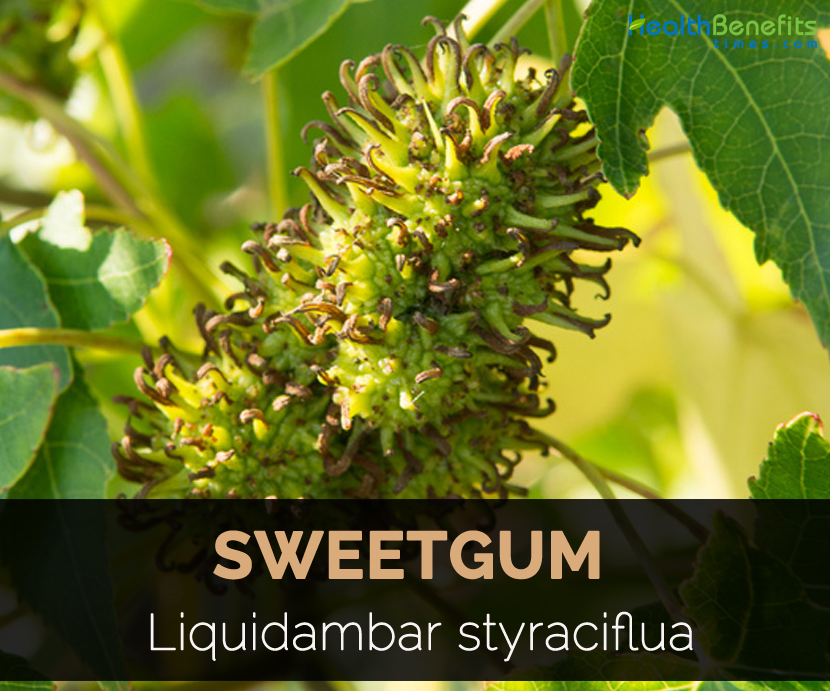| Sweetgum Quick Facts | |
|---|---|
| Name: | Sweetgum |
| Scientific Name: | Liquidambar styraciflua |
| Origin | North America |
| Colors | Brown |
| Shapes | Round, globose, 1–1.5 inches (25–38 mm) in diameter |
The tree is peculiar appearance of its small branches and twigs. Bark attaches itself to these in plates edgewise instead of laterally and piece of leafless branch with aid of little imagination readily takes on reptilian form. Bark is a light brown tinged with red and gray with dark steaks weighs 37 lbs. per cubic foot.
Leaves
Leaves have five sharply pointed palmate lobes, 3-5 inches wide on average and have three distinct bundle scars. Leaves have 6-10 cm petiole. They are rich dark green, shiny, smooth and star shaped which turns brilliant orange, red and purple colors in autumn. Leaves are 3 to 7 inches broad with glandular serrate teeth. Base is truncate and slightly heart shaped.
Facts About Sweetgum
| Name | Sweetgum |
|---|---|
| Scientific Name | Liquidambar styraciflua |
| Native | North America |
| Common/English Name | Star-Leaved Gum, Red Gum |
| Name in Other Languages | English: American-storax, Alligator-wood, Red-gum, Satin-walnut, Sweet-gum, Sweetgum; French: Copalme d’Amérique, Liquidambar; Swedish: Ambraträd; German: Amerikanischer Amberbaum |
| Soil | Deep, rich, moist, slightly acidic |
| Plant Size | 75 feet and spread to 50 feet |
| Bark | Dark and deeply furrowed |
| Leaf | Glossy, star-shaped, turns bright red, purple, yellow or orange, 3-7 inches broad, 18 cm wide with long |
| Flowering Season | March to May |
| Flower | 1-1.5 inches (25-38 mm) in diameter |
| Fruit shape & size | Round, globose, 1–1.5 inches (25–38 mm) in diameter |
| Fruit color | Brown |
| Medicinal parts | The bark and concrete juice |
Flower
Flowers bloom in March to May and are about 1 to 1.5 inches in diameter and are covered with rusty hairs. Flowers are unisexual and greenish in color. Staminate flowers form in terminal racemes about 2 to 3 inches long.
Fruit
Flowers are followed by dry, hard, globose fruit about 1-1.5 inches in diameter which comprises of numerous 40 to 60 capsules. Each capsule has one to two small seeds and a pair of terminal spikes. Woody capsules are filled with abortive seeds that resemble sawdust. Seeds are winged and one quarter of an inch thick and dispersed by wind. Winter buds are yellow brown and one fourth of an inch long. Inner scales enlarge with growing shoot and becomes half an inch long and green tipped with red.
Uses
As a remedy for catarrhs of genito-urinary passages, coughs of pulmonary affection generally, gonorrhoea, gleet, amenorrhoea, leucorrhoea, phthisis (wasting disease, tuberculosis of the lung, consumption) and asthma. Also excellent for bloody flux, dysentery and all bowel complaints of children.
Dose
1 teaspoonful of the cut or granulated bark to 1 cupful of boiling water; drink 1 or 2 cupfuls a mouthful at a time during the day; adjust to condition and age.
Externally
The balsamic juice may be melted with equal parts of olive oil or tallow as a detergent ointment when conditions of indolent ulcers, frost-bite, scabies, itch, ringworm, fistula, scrofula, fever sores and haemorrhoids are present.
Culinary uses
- Resin is used in chewing gum or as a stabilizer for cakes.
- It is also chewed to sweeten breath.
Medicinal uses
- Resin extracted from trunk acts as antiseptic, diuretic, carminative, expectorant, poultice, parasiticide, stimulant, sedative, salve and vulnerary.
- Chew the resin for treating sore throats, asthma, coughs, dysentery and cystitis.
- Apply it externally for sores, piles, wounds, ringworm, piles and scabies.
- Inner bark is used for treating diarrhea and childhood cholera.
- Add the leaves to bathes for soothing or healing skin.
References:
https://www.itis.gov/servlet/SingleRpt/SingleRpt?search_topic=TSN&search_value=19027#null
http://hort.ufl.edu/database/documents/pdf/tree_fact_sheets/liqstya.pdf
https://en.wikipedia.org/wiki/Liquidambar_styraciflua
http://tropical.theferns.info/viewtropical.php?id=Liquidambar+styraciflua
https://plants.usda.gov/plantguide/pdf/cs_list2.pdf
Comments
comments
